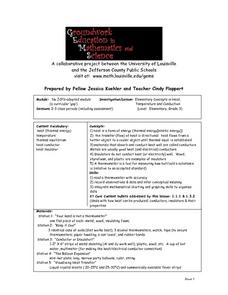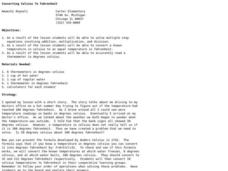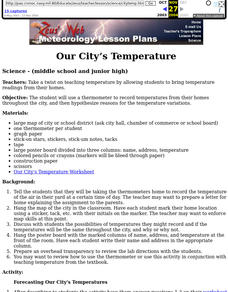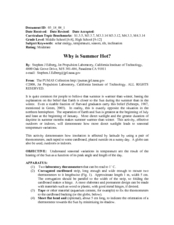Curated OER
Weather Awareness
Second graders investigate weather. In this weather lesson, 2nd graders discover how to read a temperature gauge, keep track of the weather, and find out how the weather affects their day. They work individually and in partners to make...
Texas State Energy Conservation Office
Investigation: Greenhouse Effect
Pupils compare the temperature change in a closed and open box as a demonstration of the greenhouse effect.
Curated OER
Thermometers Rising
Third graders read a Fahrenheit thermometer from an actual thermometer. In groups, they are provided with ink pads and a thermometer stamp. They use the stamps on plain white paper and use red pencil to take the temperature readings.
Curated OER
Keeping Warm
Students place words describing a range from cold to hot on a scale. Using those words, they identify places on Earth which are cold, hot, freezing or boiling. They practice using and reading a thermometer with three different beakers...
Curated OER
ESL: Reading Temperature
In this ESL temperature worksheet, students use a word box given at the top of the page to label places on a thermometer that name that temperature: cool, cold, warm, freezing or hot.
Curated OER
Book Week Celebration
Learners discover the importance of reading. They participate in a school wide book celebration. They participate in activities to get them interested in reading.
Curated OER
Your Own Greenhouse
Young science learners construct a greenhouse out of a plastic bottle. They use a nail to punch a hole through which a thermometer will be inserted to monitor the temperature. This simple experiment easily demonstrates the greenhouse...
Curated OER
Ordering Integers
Sixth and seventh graders compare and order integers. After locating integers in a newspaper, they describe examples of negative and positive integers. They draw a thermometer and locate positive and negative integers on the scale. In...
Desert Discoveries
Lizard Dash!
Here is a terrific learning game that has pupils acting like lizards! Before the game starts, there is a class discussion on the differences between endotherms and exotherms. The main focus of the game is how each team must keep their...
Curated OER
Don't Slip!
Students measure, record, and graph the force of moving a block of wood along sand paper. In this friction lesson plan, students read a spring scale, collect data, construct a graph, and propose a model to explain how fiction works.
Curated OER
Weather Dot Com
Students examine the need for a standard unit of temperature and measure temperature with a thermometer. They discuss the details of a thermometer and the calibrations used, record temperature data for inside and outside, explore...
Curated OER
Going to the Doctor: Vocabulary Cards
Flash cards are a great tool for kids with autism; use them to build a functional vocabulary. This set of nine flash cards focus in on vocabulary you'd use at the doctor's office. Consider providing sentence frames for your learners to...
Curated OER
Aspects of Weather
Students recognize and observe weather phenomena. In this four part weather lesson, students are introduced to weather symbols through a story, then use a thermometer to measure water temperature. Next, students observe the formation of...
Curated OER
Weather Instruments
Third graders make predictions about weather and utilize weather instruments and weather reports. They match weather components with weather instruments, and demonstrate how to read a thermometer. Students also construct and use a wind...
Curated OER
Elementary Concepts in Heat
Third graders read a thermometer with accuracy, record observations and data, and infer conceptual meaning. They integrate mathematical charting and graphing skills to organize their data. They explore what happens when they touch or use...
Curated OER
How Low Can You Go?
Fourth graders experience measuring temperatures after determining, by touch, whether water is hot or cold. They use a thermometers to measure the temperature of water in three cups of water. Using a vertical number line, they write the...
Curated OER
Building a Psychrometer
Students create psychrometers to measure the humidity of the air. In this meteorology lesson, students make a wet-bulb thermomter and place it next to a dry-bulb thermometer to measure the relative humidity in the room.
Curated OER
Temperature and Tracking Weather
Fourth graders discuss, describe and track weather by utilizing a variety of measurable quantities as temperature, wind speed, wind direction, cloud conditions and precipitation. They assess, through experiments and practicing, how to...
Curated OER
Life Cycle of a Salamander
Third graders examine the life cycle of a salamander. In this life cycles lesson, 3rd graders view a PowerPoint presentation about the life cycle of a salamander. Students take the temperature of a toy salamander with a thermometer and...
Curated OER
Converting Celsius to Fahrenheit
Learners convert from Celsius to Fahrenheit. In this converting lesson, students explore temperature conversions. They use a thermometer to determine the temperature of given items.
Curated OER
Our City's Temperature
Students use a thermometer to record temperatures from their homes throughout the city, and then hypothesize reasons for the temperature variations. They use a weather graph worksheet that's imbedded in this lesson to orgainize their data.
Curated OER
Why is Summer Hot?
Students examine how variations in temperature are due to the Sun and length of day. In this solar instructional activity students complete a lab activity using thermometers and artificial sunlight to see how the earth is heated.
Curated OER
Making Hail
Fourth graders investigate the different types of precipitation and conduct a hail experiment. They identify the types of precipitation during a slideshow, and define key vocabulary terms. Next, in small groups they follow the...
Curated OER
Graphing the Weather
Fourth graders predict the weather for their area using simple weather instruments. They take readings for a month during a season and graph their results. Students describe weather patterns based on their data and predict future weather...

























